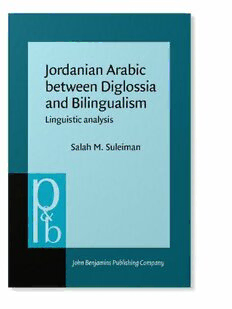
Jordanian Arabic between Diglossia and Bilingualism: Linguistic Analysis PDF
Preview Jordanian Arabic between Diglossia and Bilingualism: Linguistic Analysis
JORDANIAN ARABIC BETWEEN DIGLOSSIA AND BILINGUALISM Pragmatics & Beyond An Interdisciplinary Series of Language Studies Editors: Herman Parret (Belgian National Science Foundation, Universities of Louvain and Antwerp) Jef Verschueren (Belgian National Science Foundation, University of Antwerp) Editorial Address: Department of Germanic Languages and Literatures University of Antwerp (UIA) Universiteitsplein 1 B-2610 Wilrijk Belgium Editorial Board: Norbert Dittmar (Free University of Berlin) David Holdcroft (University of Leeds) Jacob Mey (Odense University) Jerrold M. Sadock (University of Chicago) Emanuel A. Schegloff (University of California at Los Angeles) Daniel Vanderveken (University of Quebec at Trois-Rivières) Teun A. van Dijk (University of Amsterdam) VI:8 Saleh M. Suleiman Jordanian Arabic Between Diglossia and Bilingualism: Linguistic Analysis JORDANIAN ARABIC BETWEEN DIGLOSSIA AND BILINGUALISM: LINGUISTIC ANALYSIS Saleh M. Suleiman Yarmouk University, Jordan JOHN BENJAMINS PUBLISHING COMPANY AMSTERDAM/PHILADELPHIA 1985 Library of Congress Cataloging in Publication Data Suleiman, Saleh Mahmoud Khalil. Jordanian arabic between diglossia and bilingualism. (Pragmatics & beyond, ISSN 0166-6258; VI:8) Bibliography: p. 1. Arabic language — Jordan. I. Title. II. Series. PJ6060.J67S8 1985 492'.7'095695 86-6895 ISBN 90 272 2550 8 (European) / ISBN 0-915027-94-1 (US) (alk. paper) © Copyright 1985 - John Benjamins B.V. No part of this book may be reproduced in any form, by print, photoprint, microfilm, or any other means, without written permission from the publisher. To: N and R ACKNOWLEDGMENTS I would like to take this opportunity to thank all those who made this book possible. I am particularly thankful to Dr. Riad Hussein who most graciously facilitated my reproducing parts of his doctoral dissertation entitled, "The case for triglossia in Arabic (with special emphasis on Jordan)". I am also greatly indebted to Yarmouk University through the Deanship of Scientific Research and Graduate Studies for funding my research under grants 1/82 and 73/83. For the tedious task of typing the manuscript I am deeply indebted to Ms. Nicklin for her careful work and patience. Finally, I would like to thank all the respondents who contributed tre mendously to the completion of this work. July 16,1985 TABLE OF CONTENTS LIST OF VARIANT SYMBOLS xiii PREFACE xv 1. INTRODUCTION 1 1.1 Statement of purpose 1 1.2 Definitions 1 1.2.1 Broadening the definition 2 1.2.2 Variation in definitions 3 1.3 Theory : Linguistic variation 5 1.3.1 The structural view 5 1.3.2 The descriptive view 6 1.4 Arabic diglossia 7 1.4.1 Morpho-syntax 8 1.4.2 Phonology 10 1.4.3 The phonological system of Jordanian Arabic: Main inventory 11 1.5 Lexicon 13 2. SCOPE, AIM, HYPOTHESIS AND METHODOLOGY 17 2.1 Scope 17 2.2 Aim 17 2.3 Hypothesis 18 2.4 Methodology 19 2.5 Method of collecting data 20 3. LINGUISTIC ANALYSIS OF SPEECH PATTERNS: DIGLOS SIA OR TRIGLOSSIA 23 3.1 Data analysis 23 3.2 Yarmouk University students 23 3.3 The dominance of Arabic 24 3.4 Language and dialect 24 3.5 Linguistic variables 24 3.6 Language currency 25 X CONTENTS 3.7 Distribution of dialects 26 3.8 Structural comparison of CA, MSA and KA 26 3.8.1 Vowel systems 28 3.8.2 Morphology 30 3.8.2.1 Modal and case endings 30 3.8.2.2 Numeral system 31 3.8.2.3 The loss of the dual 32 3.8.3 Syntactic comparison 32 3.8.3.1 Nominal versus verbal sentences 32 3.8.3.2 More on word order in Arabic 33 3.8.3.3 Verb deletion in the coordinate clause 38 3.9 A general view of the language situation: Domains of use 39 3.9.1 Modern standard Arabic 40 3.9.2 Domains of classical Arabic 41 3.10 The language situation among Yarmouk students 41 3.11 The KA of Yarmouk students 44 3.11.1 The Madani variety 44 3.11.2 The Fallahi variety 46 3.11.3 The Bedouin variety 48 3.11.3.1 The current status of Bedouin Arabic 50 3.11.4 An overall evaluation of colloquial Arabic (KA) 50 3.12 The non-linguistic variables 51 3.12.1 Geographical area 52 3.12.2 Sex 52 4. JORDANIAN ARABIC AND THE STATE OF BILIN- GUALISM 53 4.1 Theoretical preliminaries of bilingualism 53 4.2 Code-switching 53 4.3 Interference 55 4.3.1 Interlingual interference and language con vergence 57 4.3.2 Structure as a determinant of interference 57 4.3.3 The non-linguistic causes of interference 58 4.3.4 Interference, language contact and cultural con tent 58 4.4 Integration 60 4.5 Language contact 61 CONTENTS Xi 4.6 Linguistic analysis 62 4.7 Contrastive analysis 62 4.8 Data analysis 63 4.8.1 Phonemic substitution 63 4.8.2 Consonants 64 4.8.2.1 Under-differentiation 64 4.8.2.2 Over-differentiation 64 4.8.3 Vowels 69 4.9 Orthographic interference 73 4.10 Vowel reduction 73 4.11 Diphthongs 74 4.12 Stress 74 4.13 Theoretical implications of linguistic borrowing 75 4.14 Language mixture 78 4.15 Reasons for lexical borrowing 78 4.16 The linguistic influence of English on Arabic: Historical background 79 4.17 Listing of English loanwords 81 4.18 The significance of lexical borrowing from English 81 4.19 The phonology of loanwords 83 4.20 Morphological treatment of loanwords 86 4.21 Loanshifts 87 4.22 Influence from other languages 89 4.23 Classification of loanwords according to domains 90 5. CONCLUSION 93 5.1 General implications 93 5.2 Research findings 93 5.3 Between diglossia and bilingualism 95 FOOTNOTES 99 APPENDIX: Listing of loanwords in the colloquial Arabic of Jordan 101 REFERENCES 127 LIST OF VARIANT SYMBOLS ? ~ ' d ~ D ö ~ D J ~ j 1 ~ L r ~ R s ~ S t ~ T z ~ z ä ~ aa ê ~ ï ~ ii ö ~ oo — uu
